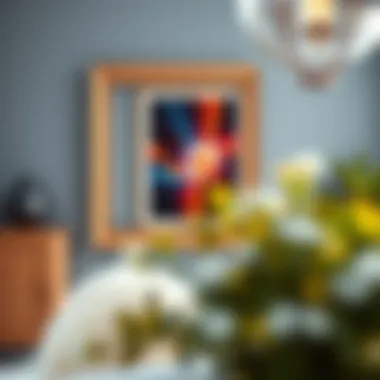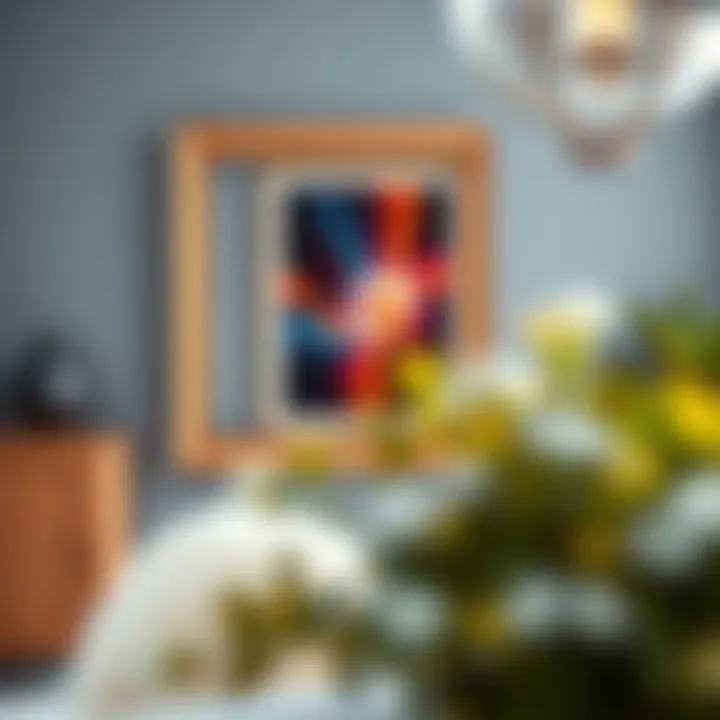Frames for Poster Prints: Styles and Aesthetic Insights


Intro
Frames don’t just hold poster prints; they’re also integral to how we perceive art in our spaces. A poster, no matter how striking the image or clever the message, can easily be overshadowed or diminished if not presented properly. The right frame can transform a simple print into a statement piece. However, choices abound, with diversity in styles, materials, and colors adding another level to the decision-making. Navigating these options takes a keen eye and appreciation for both practical utility and visual appeal.
In this exploration of frames, we'll dissect the ways they can enhance our beloved posters. This article aims to illuminate how thoughtful framing can not only protect the artwork but also uplift the entire atmosphere of a room. Whether you're a homeowner looking to add flair to your walls, or a designer crafting a space, understanding the nuances of framing can guide your selection and elevate your decor.
Preamble to Framing Posters
Framing posters is not just an aesthetic endeavor; it holds profound significance in how we present art in our Dwellings. The right frame can breathe life into even the simplest of prints, elevating them from mere images to vibrant focal points within a space. With countless styles, materials, and methods available, it’s essential to grasp the core elements influencing choice and application in framing.
Importance of Framing
When considering the impact of framing on poster prints, the importance of choosing the right frame comes into sharp focus. A properly framed poster serves several functions:
- Preservation: A frame protects prints from dust, moisture, and physical damage. This is especially vital for prints that hold sentimental value or are irreplaceable.
- Enhancement: A well-chosen frame accentuates the artwork itself, providing a visual boundary that can make colors pop and draw attention to details that might otherwise go unnoticed.
- Integration: Frames can bridge the gap between art and its environment, allowing for greater cohesion within a room’s design. Matching a frame to the decor can create harmony while showcasing personal style.
In essence, framing is not simply about putting a border around an image; it’s about transforming and enhancing the entire viewing experience.
Historical Context of Framed Art
The practice of framing artwork stretches back centuries, evolving in style and function over time. Initially, frames served a utilitarian purpose—primarily to protect art from the elements. However, as artistic movements flourished, so too did the designs of frames.
The elaborate frames of the Baroque period, for instance, were not merely protective barriers; they were statements of wealth and status, often adorned with intricate carvings that reflected the grandeur of the artwork they housed.
Fast forward to modern times, and the framing landscape has expanded dramatically:
- In the 20th century, minimalism took hold, promoting the idea that sometimes the artwork speaks best when given little context.
- Today, custom framing allows individuals to honor their unique tastes, pushing the boundaries of tradition and creativity.
In understanding the historical context of framed art, we can better appreciate the choices we make today, blending old techniques with modern sensibilities to personalize our spaces.
Types of Poster Frames
When it comes to framing posters, understanding the different types of frames can truly elevate the visual impact of your artwork. Each type brings its own flavor and functionality, making it crucial to select one that complements your poster's style and your personal aesthetic. Framing is not merely an afterthought; the right frame can transform a simple print into a focal point, encapsulating the essence of the art and enhancing the surrounding space. Below, we delve into the three main categories: Traditional Frames, Modern Frames, and Custom Frames.
Traditional Frames
Traditional frames exude a classic charm that has stood the test of time. Often made of wood, they come in a variety of finishes—ranging from ornate gold leaf patterns to rustic farmhouse styles. What’s captivating about traditional frames is their ability to blend with diverse art styles and interior decors, from vintage to contemporary.
- Aesthetic Appeal: The intricate designs can bring a sense of elegance and history—ideal for artworks that tell a story or evoke nostalgia.
- Durability: Made from sturdy materials, they stand up well to wear and tear, ensuring your cherished prints remain protected long-term.
- Versatility: These frames suit various poster genres, whether it’s a classic movie poster or a fine art print.
Using a traditional frame can create a sense of cohesion in a room styled with classic furniture or decor. If you aim to invoke a timeless feel, this option might be right up your alley.
Modern Frames
In contrast, modern frames represent a sleek, minimalist aesthetic. Typically crafted from metal or acrylic, they exemplify clean lines and bold visuals. Choosing a modern frame can make your poster feel fresh and contemporary, blending seamlessly into a modern interior.
- Simplicity: The clean look draws attention to the poster itself rather than the frame, allowing vibrant colors and designs to shine.
- Material Options: Metal frames are often lightweight yet durable, while acrylic options can create a chic, gallery-like presentation that’s easy to maintain.
- Customization: Many modern styles allow for unique configurations—such as floating frames, which highlight the depth of the artwork through a three-dimensional effect.
If you want to make a statement without overpowering your decor, modern frames typically do the trick, making your prints pop against walls painted in neutral hues or vibrant shades.
Custom Frames
For those looking to achieve a unique touch, custom frames are the ultimate solution. Tailored specifically for your artwork, they offer unlimited choices in terms of material, color, and style.
- Tailored Fit: Custom frames ensure a perfect fit for any size or shape of poster, no more worrying about those standard-size restrictions.
- Personalized Design: You have the freedom to choose every aspect, from the frame color to matting options that complement the poster’s palette.
- Attention to Detail: A well-crafted custom frame can enhance not only the artwork’s dimensions but also its narrative and emotional appeal, turning it into a piece of art that speaks directly to you.
Custom framing can be an investment, but the result is often invaluable when it comes to personal expression. Trust me, every detail—from the finish to the matting—contributes to the poster's overall presentation and significance.
"Framing is an art in itself. The right frame doesn't just encase the piece; it adds to it, allowing the viewer to experience the artwork in a new way."
Materials Used in Poster Frames


When choosing a frame for poster prints, the materials used play a crucial role. Not all materials are created equal, and each brings its unique set of benefits and considerations. Making the right choice can greatly affect the poster's longevity, appearance, and overall aesthetic in your space. Here’s a dive into the main materials commonly used in poster frames, including wood, metal, and plastic.
Wood Frames
Wood frames are often seen as the classic choice, offering both timeless elegance and durability. They come in various finishes, which allow homeowners to match them with their interior design. From rich mahogany to sleek pine, the wood grain can add warmth to any display.
Advantages of wood include its sturdiness and the ability to support larger, heavier posters without bending or warping. Furthermore, being a natural material, wood can blend beautifully with numerous decorative themes, from rustic to modern chic.
However, considerations must be made regarding exposure to moisture. Excessive humidity can cause wood to swell or crack, which may not be ideal for environments like kitchens or bathrooms. Also, wood frames often come at a higher price compared to alternatives, so budget needs to be factored in.
Metal Frames
On the other hand, metal frames, often crafted from aluminum or steel, are gaining popularity for their sleek, modern aesthetic. They are generally lighter than wood frames and less susceptible to environmental changes, making them a smart choice for high-moisture areas.
Benefits of metal frames include a clean, contemporary look that can suit any minimalistic design ethos. They are also more resistant to scratches and dents, offering a practical advantage for high-traffic areas. A distinctive characteristic of metal frames is their versatility; they can accommodate various matting options, enhancing the overall presentation of the artwork.
Yet, it’s essential to acknowledge that metal frames can lack some warmth and texture that wood offers. Additionally, they often come in limited color options, which may restrict creative expression if one is looking for a specific look to coordinate with their decor.
Plastic Frames
Finally, plastic frames present a budget-friendly option that still delivers style. Typically made from materials like polystyrene, they can effectively mimic the look of wood or metal without the hefty price tag. For those who like to frequently change their displays, plastic frames can be particularly appealing due to their lightweight design and availability in a vast range of colors and styles.
While plastic frames are cost-effective, they may not provide the same level of durability as wood or metal. They tend to be more susceptible to bending and less resilient against environmental factors. However, the lightweight nature makes them easy to handle and hang, which is a significant advantage for transient living spaces like college dorms or rental homes.
Choosing the Right Frame
Selecting the right frame for your poster prints is like choosing the perfect outfit for an occasion; it not only complements but elevates. A frame does not merely serve a functional purpose; it sets the tone of the artwork and communicates a style. A wall adorned with thoughtfully chosen frames can convey a narrative about your taste and personality. When homeowners or designers choose the right frame, they are making a statement about the atmosphere they want to create within their spaces.
Several factors come into play while picking out the ideal frame, from personal style preferences to the atmosphere of the room. The significance of this choice cannot be overstated as it can either enhance or diminish the visual impact of the artwork. A framed poster is often the focal point of a room, and the right frame can draw attention while providing context to the piece it houses.
Considerations for Style and Theme
Understanding the intricacies of style and theme is essential when choosing a frame. If your poster print is a vibrant, abstract piece, a sleek, minimalist frame may serve to accentuate its colors without overwhelming it. Conversely, a vintage print might look best in a decorative, ornate frame that echoes its historical feel.
Here are some considerations to help steer your choice:
- Cohesiveness: Ensure your frame complements other decor elements within the space, maintaining a flow rather than a jarring dissonance.
- Artistic Intent: Consider what the artwork intends to convey. For instance, a somber piece might best resonate within a subdued, muted frame.
- Color Palettes: Notice the color spectrum of the artwork. A frame in a neutral tone can work wonders in emphasizing intricate colors, while vibrant hues can provide an energetic contrast.
- Room Function: The function of a room should influence your decision as well. A playful frame in a children's room might be more appropriate, while a sophisticated design could suit a home office.
Match Your Frame with Artwork
Pairing your frame to the artwork requires a keen eye and a bit of intuition. It's not simply about fitting the frame dimensions; it's about creating harmony between picture and frame.
- Size Matters: A large piece of artwork requires a frame that holds its own. An underwhelming frame can make the piece seem small and insignificant.
- Orientation: Landscape-oriented posters may benefit from wider frames that extend the width visually, while portrait pieces often look best with taller, slimmer frames.
- Material Choices: The material of the frame should also align with the artwork’s medium. A canvas print might benefit from a thick, rustic wood frame, while a sleek photograph could look striking in a thin metallic frame.
Incorporating these considerations when framing not just aligns with aesthetic sensibilities but also protects the artwork in the long run. Remember, the right frame is akin to a good pair of shoes—they hold everything together, providing support while accentuating the beauty of what they’re designed to showcase.
Color Spectrum in Framing
The color spectrum in framing is not merely a superficial consideration; it plays a critical role in how a framed poster is perceived within a space. Color has the power to evoke emotions, set moods, and even influence the aesthetic harmony of a room. When undertaking the task of framing a poster, understanding how color interacts with both the artwork and the surrounding decor is essential for achieving the desired overall effect.
Neutral Tones
Neutral tones provide a calming backdrop that can complement a wide variety of artwork. Shades such as beige, gray, and off-white are all part of this family. They possess a unique ability to blend seamlessly with many color palettes, thereby drawing attention back to the artwork itself rather than the frame.
For instance, if you have a colorful poster bursting with vivid hues, pairing it with a simple gray frame can help balance the explosion of color, allowing the details of the artwork to emerge more prominently. Moreover, neutral frames can establish an air of sophistication, aligning well with modern minimalist decor or traditional styles alike.
- Benefits of Neutral Frames:
- Versatile and adaptable to various artworks.
- Helps in making brighter colors pop without competition.
- Provides a timeless look that doesn’t go out of style.
If you decide to frame a black-and-white poster, consider how a matte black or soft white frame will assert your design choices. The subtlety of neutral tones combined with striking artwork can create a stunning focal point in any room.


Vibrant Hues
On the other side of the spectrum, vibrant hues can add dynamism and a sense of enthusiasm to framed posters. Bold colors like red, blue, or yellow are not only eye-catching but also make a statement, especially in rooms that thrive on energy and creativity.
Using a vibrant frame can significantly alter the perception of the overall artwork. For example, a bright green frame around nature-themed prints can enhance the fresh feel of the imagery, whereas a fiery red frame might inject life and intensity into a calm scene.
- Key Considerations for Vibrant Frames:
- Ensure the frame color harmonizes with featured colors in the artwork.
- Use vibrant frames in art pieces meant to be statement pieces themselves.
- Explore complementary colors for frames to create a cohesive look.
Adding a touch of bright color draws the eye and can breathe life into an otherwise understated environment. However, one must tread carefully; overcrowding a space with too much color can lead to visual chaos.
"Color is the keyboard, the eyes are the harmonies, the soul is the piano with many strings." - WASSILY KANDINSKY
Enhancing Aesthetics Through Matting
Matting plays a pivotal role in transforming a simple poster into a stunning focal point in any room. The right mat not only provides physical support for the artwork but also adds depth and dimension, enhancing the visual appeal. Choosing to incorporate matting elevates the overall presentation of the framed piece, allowing it to stand out and resonate with the viewer.
Matting acts as a buffer between your poster and the frame, effectively keeping the artwork safe from damage caused by contact with the frame's inner edges. Yet, its benefits stretch beyond mere protection. A carefully selected mat can highlight colors within the image, guide the eye towards crucial details, and create a sophisticated finish.
Moreover, the versatility of matting allows it to complement various decor styles. From minimalist designs that lean heavily on neutral shades to vibrant mats that echo the artwork’s hues, there are endless options to explore. Additionally, using multiple mats can introduce a layered effect, which not only enhances aesthetic appeal but can also increase the perceived depth of the piece.
Understanding Matting
Matting, in the framing context, refers to the fine border of material placed between the frame and the poster. It serves a functional purpose, but it features a myriad of aesthetic possibilities. The mat material itself is often made from acid-free paper or cotton, ensuring that it won’t cause discoloration over time.
When deciding on mat thickness, one must consider balance; a broader mat can enlarge the visual space your poster occupies, making it feel more significant. Conversely, a slimmer mat may work well in tight spaces where the focus needs to remain on the image itself.
Benefits of Matting:
- Protection: Prevents direct contact between the artwork and the frame.
- Enhancement: Improves depth and adds visual interest to the framed piece.
- Versatility: Complements diverse styles of decor and artwork.
“A mat is like a well-tailored suit; it enhances the look without overshadowing what lies beneath.”
Choosing the Right Mat Color
Selecting a mat color can be both an art and a science. The goal is to choose a hue that accentuates the artwork while ensuring it harmonizes with the surrounding decor. Here are a few points to mull over when making your choice:
- Complementing Colors: Look for colors within your artwork that can be enhanced by the matting. For instance, if your poster features a splash of crimson, opting for a soft blush mat can create a thoughtful connection.
- Neutral Options: Sometimes, going for neutral colors like beige, gray, or white provides a clean backdrop that allows your artwork to shine. This approach is beneficial in spaces where the goal is to maintain a subtle atmosphere.
- Bold Statements: A vibrant, contrasting mat can evoke strong emotions or draw attention to certain aspects of the piece. Use this thoughtfully, ensuring it aligns with your overall decor theme.
While experimenting, it helps to lay out a few options against your poster. This way, you can see how different colors interact with each other in real-time, allowing your choices to reflect the emotional tone you wish to convey.
Display Techniques for Framed Posters
When it comes to showcasing your framed posters, the techniques you choose to display them can greatly affect the visual impact of your decor. Think of picture frames as the jewelry for your walls—although the artwork itself might be stunning, the way you present it plays a huge role in how it’s perceived. This section discusses various display techniques that not only enhance the appearance of the framed posters but also create an inviting atmosphere in your home.
Wall Mounting Options
Wall mounting is perhaps the most common method of displaying framed posters. This technique allows you to leverage vertical space creatively, transforming an ordinary wall into a gallery that tells a story.
Considerations for Wall Mounting:
- Height: It’s crucial to hang your artwork at eye level. A general guide is to position the center of the piece around 56 to 60 inches from the floor. This way, it invites viewers to pause and appreciate.
- Spacing: When displaying multiple pieces, the spacing should be consistent. Typically, 2 to 4 inches between frames is ideal. This uniformity creates a cohesive look while allowing each poster their moment to shine.
- Groupings: You might opt for a utilitarian grid layout or a more relaxed, salon-style arrangement. The former lends an air of modernity, while the latter can evoke nostalgia. Whichever style you choose, ensure there’s a visual balance to draw the eye without overwhelming it.
"A well-placed frame can make a room feel alive, as if the walls themselves are whispering stories to those willing to look."
Tabletop Displays
If wall space is at a premium or you prefer a versatile approach, tabletop displays offer an alternative that’s both flexible and engaging. This technique allows for frequent rearrangement, letting you keep your decor feeling fresh.
Key Points for Tabletop Displays:


- Surface Selection: Consider where you’ll place your frames. A well-styled coffee table or an elegant sideboard can benefit from the addition of framed posters. Use contrasting heights to create interest—mix small frames with larger ones.
- Accessorizing: Enhance your framed posters by surrounding them with complementary decor items. Think about incorporating plants, books, or decorative objects that tie into the theme of your posters—it's all about creating a visual narrative.
- Layering: Don’t be afraid to layer frames. A larger piece can serve as a backdrop for a smaller frame in the front, adding depth and dimension to your setup.
Incorporating these display techniques for framed posters doesn’t just beautify a space; it also reflects personal style and the story you want to tell. Choosing the right way to showcase art adds significant value to your living spaces—making them not only aesthetically pleasing but deeply personal.
Care and Maintenance of Frames
Maintaining the integrity of framed posters is crucial not only for aesthetic purposes but also for ensuring the longevity of the artwork contained within. Frames serve as protective borders that can either enhance or detract from the visual appeal of your posters. Neglecting regular care can lead to unsightly damage, reducing the overall impact of your decor. Thus, understanding proper care and maintenance is essential for homeowners and designers alike.
Cleaning Tips
When dust settles on your frames, it can create a dull appearance that hides the beauty of your poster. Here are some easy cleaning strategies:
- Dust Regularly: Use a soft microfiber cloth to gently wipe surfaces. This will prevent dust from building up.
- Choose Safe Cleaning Products: For glass frames, a mixture of water and vinegar can do wonders. Just avoid harsh chemicals that can scratch or damage finishes.
- Handle with Care: When cleaning, always support the frame and avoid putting too much pressure on the corners.
- Avoid Direct Sunlight: Frames can fade over time if exposed to direct sunlight. Positioning them wisely can minimize fading.
Using these tips ensures that your frames remain as striking as when you first hung them.
Preventing Damage
To keep your framed posters in tip-top shape, it's vital to consider a few preventative measures:
- Temperature Control: Extreme temperatures and humidity can warp frames and degrade artwork. Keeping your room at a stable temperature can make a significant difference.
- Use UV-Resistant Glass: If your frames are exposed to sunlight, investing in UV-filtering glass can protect your art from fading.
- Secure Mounting: Ensure your frames are properly mounted. Using frame hooks or brackets will maintain their position and prevent falls, which could lead to costly damage.
- Avoid Cluttering: Keep items away from frames that could spill or create a mess, such as plants or food.
Following these measures can save you from potential heartache down the road. A little attention today goes a long way in preserving the beauty of your spacing for years to come.
Sustainable Framing Practices
Framing is not just about aesthetics; it plays a significant role in impacting our environment. Sustainable framing practices focus on methods and materials that reduce ecological harm while ensuring that art doesn't compromise nature. It's about creating a beautiful environment without sacrificing the planet's health in the process. Embracing sustainability in framing can contribute to considerable benefits, from reducing waste to supporting ethical practices in manufacturing.
Eco-Friendly Materials
Selecting eco-friendly materials is at the heart of sustainable framing. These materials do not just resonate with our aesthetic preferences but also align with environmentally conscious choices. Here are some options to consider:
- Reclaimed Wood: This option gives new life to materials that might otherwise end up in landfills. It offers character and uniqueness to each frame, thus nurturing a connection between the art and its surroundings.
- Bamboo: Fast-growing and sustainable, bamboo frames are an excellent choice. They require less energy to process compared to traditional hardwoods, making them a greener alternative.
- Recycled Glass: Instead of using new glass, consider optng for recycled glass. It reduces the demand on natural resources while adding clarity to the framed art.
- Non-Toxic Adhesives and Finishes: Many adhesives and finishes contain harmful substances. Switching to non-toxic, water-based options can lower the chemical footprint.
By utilizing eco-friendly materials, homeowners and designers not only enhance their aesthetic choices but also contribute to a healthier planet.
Ethical Sourcing Considerations
Beyond just the materials used, ethical sourcing should be a pivotal aspect of sustainable framing practices. This involves understanding where materials come from and how they are harvested. Here are some considerations:
- Certification: Look for certified sources like the Forest Stewardship Council (FSC) which ensures that the wood is sourced from responsibly managed forests. Certification guarantees that the frames are made without contributing to deforestation.
- Local Sourcing: Whenever possible, opt for frames sourced locally. This not only supports the local economy but also reduces carbon emissions associated with transportation.
- Labor Practices: Ensure that manufacturers uphold fair labor standards. Supporting companies that provide fair wages and safe working conditions fosters a better global community.
Incorporating sustainable practices in framing is a blend of style, responsibility, and care. Choosing wisely uplifts not just your decor but contributes to a larger cause.
In summary, focusing on sustainable framing practices in poster prints means making discerning decisions about both materials and manufacturing methods. These choices not only transform your space but also play an integral part in nurturing the planet. As we become more mindful consumers, our small changes lead to big impacts.
Final Thoughts on Poster Framing
Framing is not just about selecting a border for your artwork; it's an essential element that contributes to the overall aesthetic and emotional impact of a space. In today's world, where art is more accessible than ever, understanding the nuances of framing can make a significant difference in how your posters are perceived. This final section seeks to underline the importance of thoughtful poster framing, reinforcing its value in both everyday living and decorative pursuits.
Personalizing Your Space
To truly make a space your own, personal touches are essential. Artwork, especially when appropriately framed, plays a pivotal role in reflecting one’s personality and tastes. Whether you lean towards the bold colors of abstract art or prefer the subtle tones of a vintage poster, the right frame can elevate the visual appeal tremendously.
When selecting a frame, consider how it harmonizes with your existing decor. Are your walls painted in a calming hue, or do they burst with color? Matching your frame style and color with the room can help create a cohesive look. For instance, a sleek metal frame might blend well in a modern room, while an ornate wooden frame could add character and warmth to a more traditional setting.
- Use the frame to complement your artwork.
- If your piece features vivid colors, a neutral frame can ground the composition.
- A colorful frame can add a fun element, making it a focal point in a room.
Many homeowners forget how the arrangement of different framed pieces can change the dynamics of a room. Spacing, orientation, and grouping the artwork are crucial considerations. A well-organized gallery wall can breathe life into a dull corridor or an empty living room.
The Value of Art in Home Decor
Art does more than just beautify a space; it can set the mood, evoke memories, and inspire creativity. The addition of framed posters to your home can give it character and tell stories unique to you. Each piece chosen is a testament to personal interests, travels, or passions.
Moreover, art has a significant psychological effect. Well-placed artwork can enhance feelings of happiness and relaxation, while also stimulating thought and discussion among guests. In homes where personalities are on display, art framed with intention becomes a conversation starter. It’s not just about aesthetics; it’s about creating an environment that resonates with the people who inhabit the space.
“Art is the most beautiful of all lies.” – Pablo Picasso
Understanding this value is the first step in creating a beautiful, personalized, and inspiring environment.
For further insights into framing and art placement, check out resources like Wikipedia or explore design communities on Reddit.



